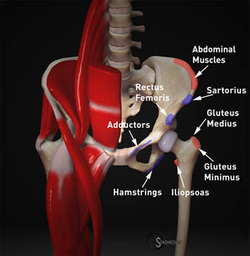Apophyseal Avulsion Injuries

Image 36
- Most commonly occur in children participating in strenuous sporting activities
- The athlete will usually present with pain, which may be extreme, localized tenderness, and limitation of motion about the site of the avulsion injury.
- Acute avulsion injuries typically occur as the result of sudden, violent, forceful concentric or eccentric muscular contraction without external trauma.
- A high number of these patients report mild groin pain prior to the actual acute avulsion event.
- A second mechanism of acute avulsion reported by others is sudden excessive passive lengthening of a muscle such as that seen in gymnasts or cheerleaders who perform splits.
- Several authors have also described chronic avulsion injuries in which no single inciting event could be recalled. The proposed mechanism of injury is chronic traction from repetitive trauma with ultimate displacement of the apophysis. It is this displacement which distinguishes the chronic apophyseal avulsion injury from apophysitis. Such patients typically present with persistent pain in the region of the hip or pelvis which restricts participation in or limits optimal performance of athletic activity.
In the picture, the most common sites are in blue and the less common sites are in red.
(8)
